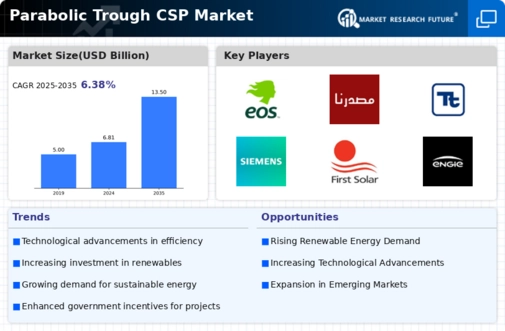Technological Innovations
Technological advancements play a crucial role in shaping the Parabolic Trough CSP Market. Innovations in materials, design, and efficiency have led to enhanced performance and reduced costs of parabolic trough systems. For instance, the development of advanced heat transfer fluids and improved mirror designs has increased the overall efficiency of these systems. Recent studies indicate that the efficiency of parabolic trough systems has improved by approximately 15% over the past decade. These innovations not only make parabolic trough systems more competitive against other renewable technologies but also expand their applicability in various regions. As technology continues to evolve, the Parabolic Trough CSP Market is likely to experience further growth driven by these advancements.
Government Policies and Incentives
Supportive government policies and incentives are pivotal in driving the Parabolic Trough CSP Market. Many countries have implemented favorable regulations, tax credits, and subsidies to promote the adoption of renewable energy technologies. For example, feed-in tariffs and renewable portfolio standards have been established to encourage investment in solar energy projects. Data suggests that regions with strong policy frameworks have seen a significant increase in the deployment of parabolic trough systems, with some countries reporting growth rates exceeding 20% in installed capacity. These incentives not only lower the financial barriers for developers but also enhance the attractiveness of parabolic trough systems as a viable energy solution, thereby propelling the market forward.
Rising Demand for Renewable Energy
The increasing The Parabolic Trough CSP Industry. As nations strive to meet their energy needs sustainably, the demand for solar power technologies, including parabolic trough systems, is expected to rise. According to recent data, the renewable energy sector has seen a compound annual growth rate of over 8%, indicating a robust shift towards cleaner energy solutions. This trend is further fueled by public awareness of climate change and the need for energy independence. Consequently, the Parabolic Trough CSP Market is poised to benefit from this growing demand, as these systems offer a reliable and efficient means of harnessing solar energy, thus contributing to a more sustainable energy landscape.
Increasing Energy Security Concerns
The growing concerns regarding energy security are influencing the Parabolic Trough CSP Market. As geopolitical tensions and fluctuating fossil fuel prices create uncertainty, nations are increasingly looking for stable and sustainable energy sources. Parabolic trough systems provide a reliable alternative, as they harness abundant solar resources, reducing dependence on imported fuels. Recent analyses indicate that countries investing in solar energy technologies, including parabolic trough systems, are better positioned to achieve energy independence. This shift towards renewable energy not only mitigates risks associated with fossil fuel volatility but also aligns with long-term sustainability goals. Consequently, the Parabolic Trough CSP Market is likely to see heightened interest as countries prioritize energy security.
Growing Investment in Infrastructure
The surge in investment in renewable energy infrastructure is a significant driver for the Parabolic Trough CSP Market. As financial institutions and private investors increasingly recognize the potential of solar energy, funding for parabolic trough projects has expanded. Recent reports indicate that investments in solar thermal technologies have reached several billion dollars, reflecting a strong commitment to developing renewable energy infrastructure. This influx of capital not only facilitates the construction of new parabolic trough plants but also supports research and development initiatives aimed at improving system efficiency and reducing costs. As investment continues to grow, the Parabolic Trough CSP Market is expected to flourish, driven by enhanced infrastructure and technological advancements.


















Leave a Comment